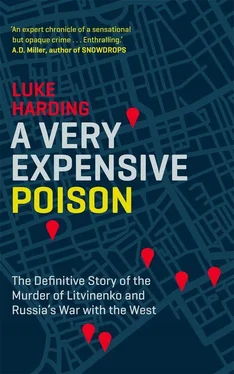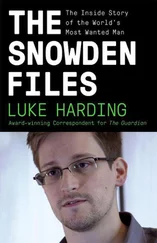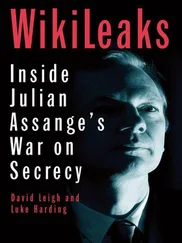‘He was a friend. I miss him. I’m very grateful to Boris. Through him I felt the touch of history,’ Goldfarb said. For better or worse, he added, Berezovsky had played a major role in the 1990s: advising Yeltsin, bringing peace to Chechnya and promoting Putin – his biggest error. One of the mourners was Rabinowitz, his QC. What did he make of Berezovsky? Rabinowitz, walking along a path lined with rhododendrons, and in meditative mood, told me: ‘He was very Russian, like something from the pages of a Dostoyevsky novel.’
* * *
In March 2014, an inquest opened into Berezovsky’s death. The two-day hearing in Windsor heard evidence that confirmed suicide. Dr Simon Poole, a forensic scientist, said that microscopic tests of the tissues on Berezovsky’s neck revealed no sign of any restraint or defence injuries. Toxicology tests didn’t turn up any poisons. Another scientist, Dr Raymond Fysh, said he saw no evidence that Berezovsky had been strangled.
A German forensic pathologist, Professor Bernd Brinkmann, disagreed. Brinkmann didn’t examine Berezovsky’s corpse but he did review autopsy photographs. He concluded that the businessman didn’t kill himself. His report, commissioned by Berezovsky’s family, said that a number of assailants may have murdered Berezovsky, suspending him by his scarf from the shower rail. ‘The strangulation mark is completely different from the strangulation mark in hanging,’ Brinkmann said. An assailant could have throttled him in a bedroom, he posited.
Brinkmann was an interesting witness. It was Brinkmann who had proved that the Italian banker Roberto Calvi – found hanging from Blackfriars Bridge in 1982 – had been murdered. Calvi’s family had never believed the official version of suicide; Brinkmann’s report two decades later led police to reopen the case as a murder inquiry. The killers appeared to be the Sicilian mafia. In 2005, five Italians were tried for Calvi’s murder but acquitted.
This time, however, the coroner Peter Bedford was sceptical of Brinkmann’s conclusions. Bedford said it was unlikely anyone could have attacked Berezovsky ‘without any reaction’ from him. Rather, Bedford said that there was convincing evidence that Berezovsky – depressed, and under financial pressure – was capable of suicide. However, Bedford acknowledged that Brinkmann was an eminent witness. He entered an open verdict.
This meant the cause of death was impossible to determine. It could be either murder or suicide. Thames Valley Police were privately irritated with the verdict and Brinkmann’s evidence.
The family still believe Berezovsky was murdered. Yelizaveta Berezovskaya, daughter by his first marriage, pointed a finger at the Russian government. She told the inquest a number of people would be interested in having him killed. The motive, she suggested, was obvious: for more than a decade Berezovsky had warned that Putin wasn’t merely a danger to Russia but was capable of menacing other countries too.
Recent events had proved him right. ‘I don’t think they liked what my father was saying. He was saying that Putin was a danger to the whole world. And you can see that now,’ she said.
It was hard to disagree with that. Days earlier, Putin had annexed a large chunk of someone else’s territory.
Putin seemed unstoppable. But just a few months before Berezovsky’s demise, another mysterious death of a Russian émigré on British soil was to raise still further questions that were to resonate at the very top of international politics.
10
Gelsemium Elegans
St George’s Hill, Weybridge, Surrey, 10 November 2012
‘The only possible way to imitate a natural death without arousing suspicion was to use poison. An accident would not suit – they always left a lingering odour of suspicion’
THE DEATH OF ACHILLES, BORIS AKUNIN, 1998
The names sound quintessentially English – Silverwood, Horsley, Bassett Lodge, Hawthorn Mill. Each refers to a mansion on the private St George’s Hill estate in Weybridge. The houses here are large – think three-storey mock-Tudor mansions with dormer windows, sweeping driveways and triple garages. Their owners are rich people. Naturally enough, they value their privacy. Signs suggest that outsiders and those who are not members of the local golf club can piss off. Guardhouses limit access at the entrances. Branded estate vehicles buzz along the woody drives.
St George’s is Britain’s bucolic answer to Beverly Hills. Celebrities like this green corner of Surrey, immediately south-west of London. John Lennon, Ringo Starr, Elton John and Tom Jones have all lived here. Others keep a low profile for different reasons. There are hedge fund managers, City bankers, a Nigerian computer tycoon. Their personal accounts and investments – all legal and declared, of course – amount to millions. Contractors are used to installing bulletproof glass and panic rooms for some of the more particular residents.
Granville Road is a typical St George’s address. At its entrance is a white barred gate. A notice in front of a large rhododendron says: ‘Restricted access’. Fifteen-foot-high hedges of laurel and copper beech shield the houses and their enormous gardens from view. CCTV cameras are everywhere. As one police officer told the Observer newspaper: ‘Even the security has security.’ If you want to disappear this is a good spot, a wooded refugium of silver birch and pine.
On 10 November 2012, one St George’s resident was returning from an early-evening jog. It was 5.15 p.m. The runner, dressed in a tracksuit, turned into Granville Road. Ahead of him was his home in exile, the Coach House, which he shared with his wife Tatiana and their two children. The property was at the end of a turning circle. The house was imposing – six bedrooms, £12,500 a month rent, a Porsche parked outside. In the garden was a kids’ trampoline.
Fifty metres from his front door, the jogger collapsed. He didn’t get up. He lay face down on the ground.
Police arriving at the scene jotted down a few details. The man’s name was Alexander Perepilichnyy. He was a Russian citizen and forty-four years old. He had previously been in excellent health. Like Litvinenko, Perepilichnyy had fled to the UK from Moscow after a dispute with some powerful people there. Since 2010, he had been living anonymously and quietly with his family in St George’s, avoiding trouble. Latterly, he’d been receiving some worrying messages from Russia.
Perepilichnyy lay motionless under a white sheet. A single lamp-post illuminated the darkness. Liam Walsh, a local chef, said that when he arrived at the scene the Russian wasn’t breathing. ‘We had to get him on his back and start doing CPR. He was probably dead for a while,’ Walsh told Reuters. There was zero paramedics could do. No obvious cause of death. No obvious sign of foul play either. Unexplained, then.
It would take more than two years before the likely murder weapon was discovered, and then not by men in uniform. The weapon was a rare and deadly toxin. It had been on a journey as improbable as that taken by the polonium from a closed nuclear city in the Urals to the streets of Mayfair. Whoever was responsible had shown a high degree of cunning. Was this the FSB? The toxin came from a plant. A plant that grows on the hillsides of China.
* * *
If he’d been born a couple of decades earlier, Perepilichnyy might have been a professor. Maybe even a member of the Soviet Union’s prestigious academy of sciences. He was a talented physicist and maths whizz. Born in Western Ukraine, he moved to Moscow in the 1980s to study at the Physical and Technological University in the faculty of molecular and biological physics. In his student days Perepilichnyy was a vertical, skinny figure, with gangling legs, jet-black hair and pale skin. He preferred black clothes. His expression was somewhat absent, as if he was thinking about something. He was an introvert, serious and deadpan, even when making a joke. Friends called him Stanek.
Читать дальше












